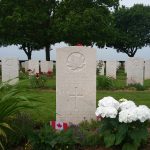Today was a busy day. Starting off this tour, I was a little apprehensive about the itinerary, meeting new people, and the academic work that accompanied it. After arriving in France today (May 26) I realised that all my concerns were misplaced. We all have something that draws us together, only making this trip more memorable.
We began our Battlefield tour by visiting the museum in Péronne. The display was like nothing I had ever seen, and it was interesting how it was strung together. See, Péronne resides near the First World War battlefield of the Somme. When I was learning history, the stories I heard about the Somme were gruesome. It was difficult not to judge. You hear of soldiers marching towards the German trenches instead of running, and as a result being mowed down by machine-gun fire. I had a teacher who always said, “you are only as good as your last war.” For the soldiers of the First World War, this statement seems accurate, and as historians we look back at the war with 20/20 hindsight. In truth, probably the best my sight has ever been.
The museum presents how the various levels of society address war. Nationally, there is a big push to support the war. It is hard to convince people to fight and die for a cause that is not supported by leaders. Ultimately, that is one of the reasons why the First World War was so disastrous. In the national section of the gallery, there were objects of prior wars, glorifying the prospect of dying. A term used by Wilfred Owen, but first attributed to Horace, is the phrase “dulce et decorum est pro patria mori.” It is sweet and proper to die for one’s country is the message that Owen was mocking. This form of memory, that the World War was brutal, emerged once it was too late. I can’t begin to understand the mindset of these people who lived and died during the First World War, but the objects presented by this museum make it easier to believe that it isn’t straightforward.
While the soldiers were fighting, the people at home were buying into the belief that the sacrifice of those fighting on the Western Front was necessary. It doesn’t matter if their beliefs are right or wrong. They are the people who contribute to history, and it is their beliefs and memories that historians need to address to help develop a bigger picture of the First World War.
The other galleries of the museum break down the experience into societal perspectives, including the lives of the soldiers, and the people they left at home. One of the most haunting images for me was a child’s outfit designed as a mini soldier’s uniform. This mentality challenges the narratives of the First World War. How can we condemn a war that was supported by all levels of society, not just the leaders?
The museum presents a lot of useful information that I could discuss, but I would end up writing more than necessary. If you have the ability to visit the museum, do so.
After the museum, we travelled up to Ypres, a major battle for allied troops. When we arrived, all we saw was a beautiful location with a giant statue named “the Brooding Soldier.” It is intended to represent the sacrifice made by the allied nations during the various battles of Ypres, but also the Canadians. This statue is imposing. It is a long obelisk like memorial with a First World War soldier at the top with his head bowed. What the message is depends on the person, but for me, I saw someone who was respecting the sacrifice made by not only Canadians, but all soldiers who fought in the war. It didn’t matter about national or personal beliefs, dispelling the questions and concerns historians have about the First World War. Nothing mattered but remembering the sacrifice of those who fought.
For me, it was easy to imagine soldiers and trenches in the fields behind the monument, battles raging. It was a complete juxtaposition compared to the day that we had. I always imagine the First World War to be grim, dark, and rainy. They would have seen the sun shining down onto the battlefield, where 100 years later we stood. The day was beautiful, not a cloud in the sky and the sun shining down. It is difficult to describe the emotions associated with every sight, but today I have felt a mix of happiness, despair, hope, and the ultimate sacrifice that any soldier was expected to make.
And that was only the first day…
Catherine S.

